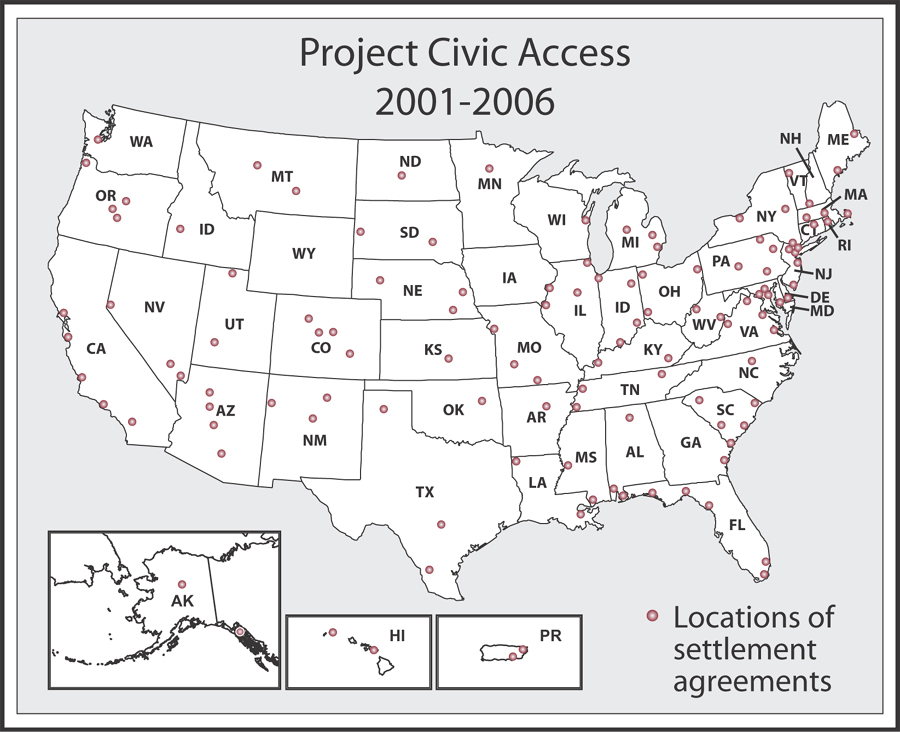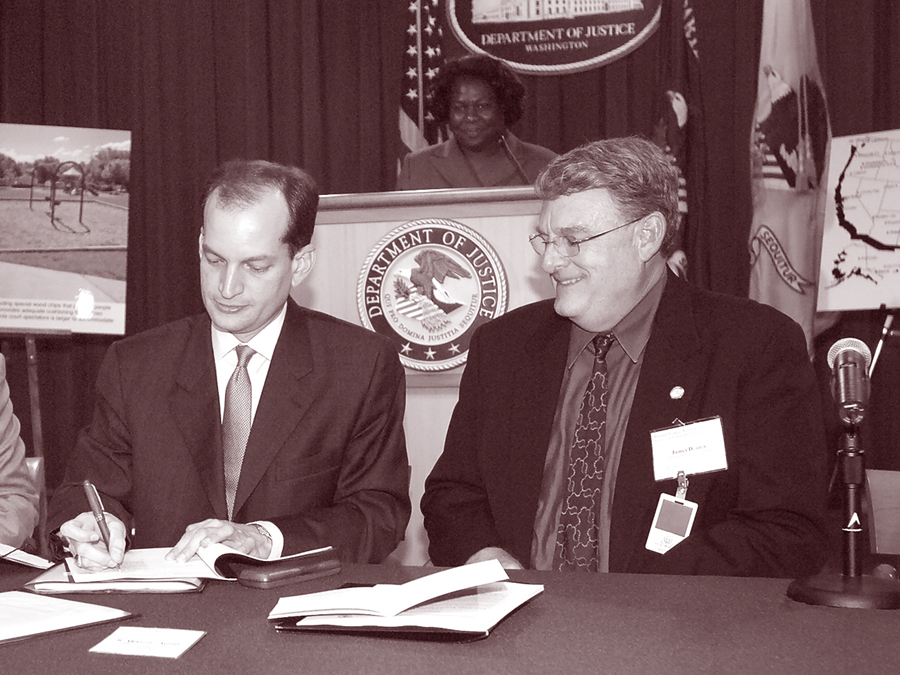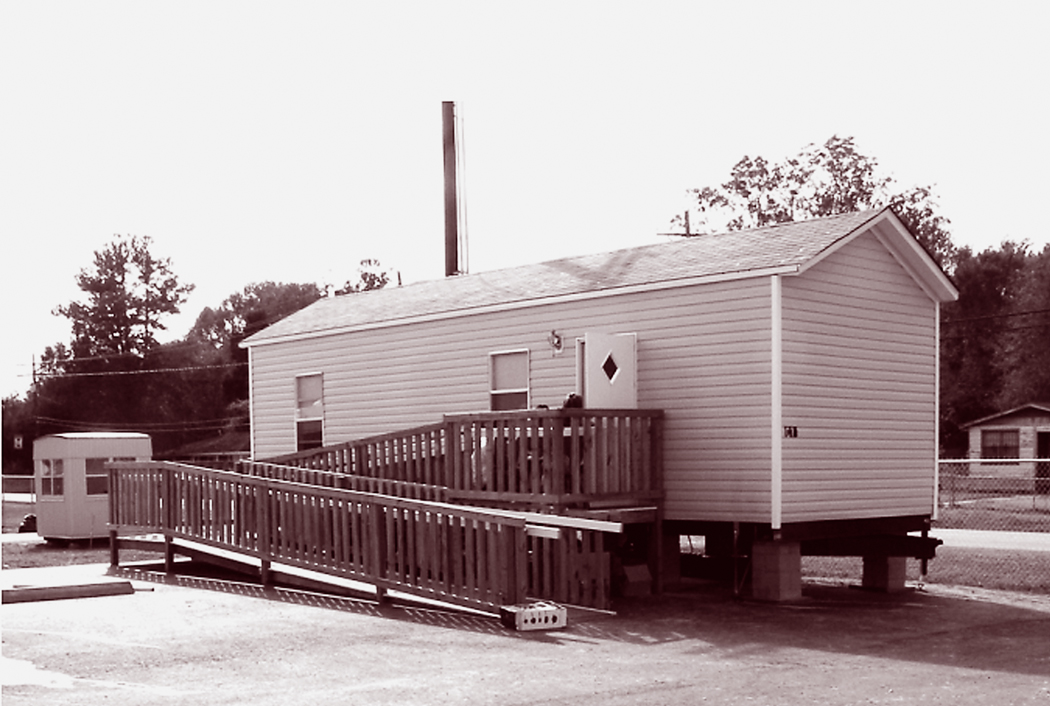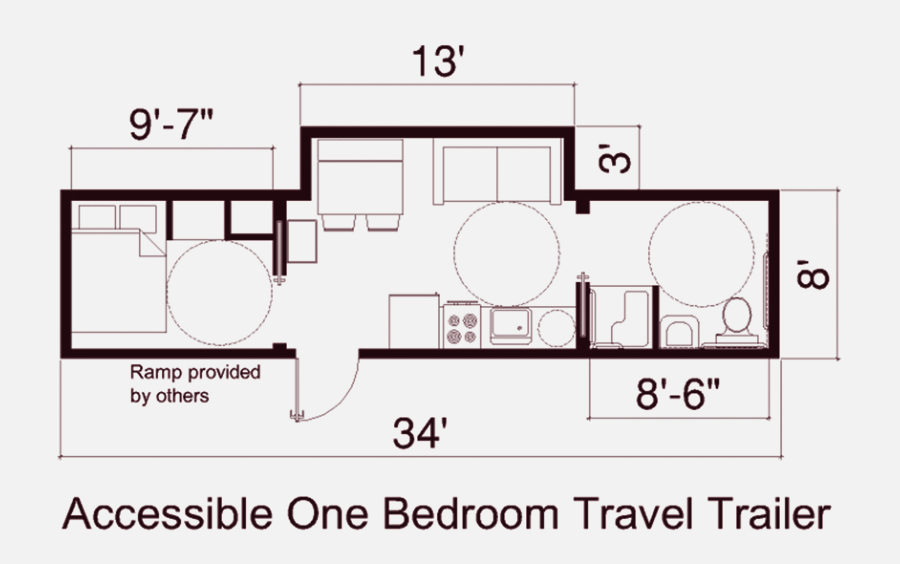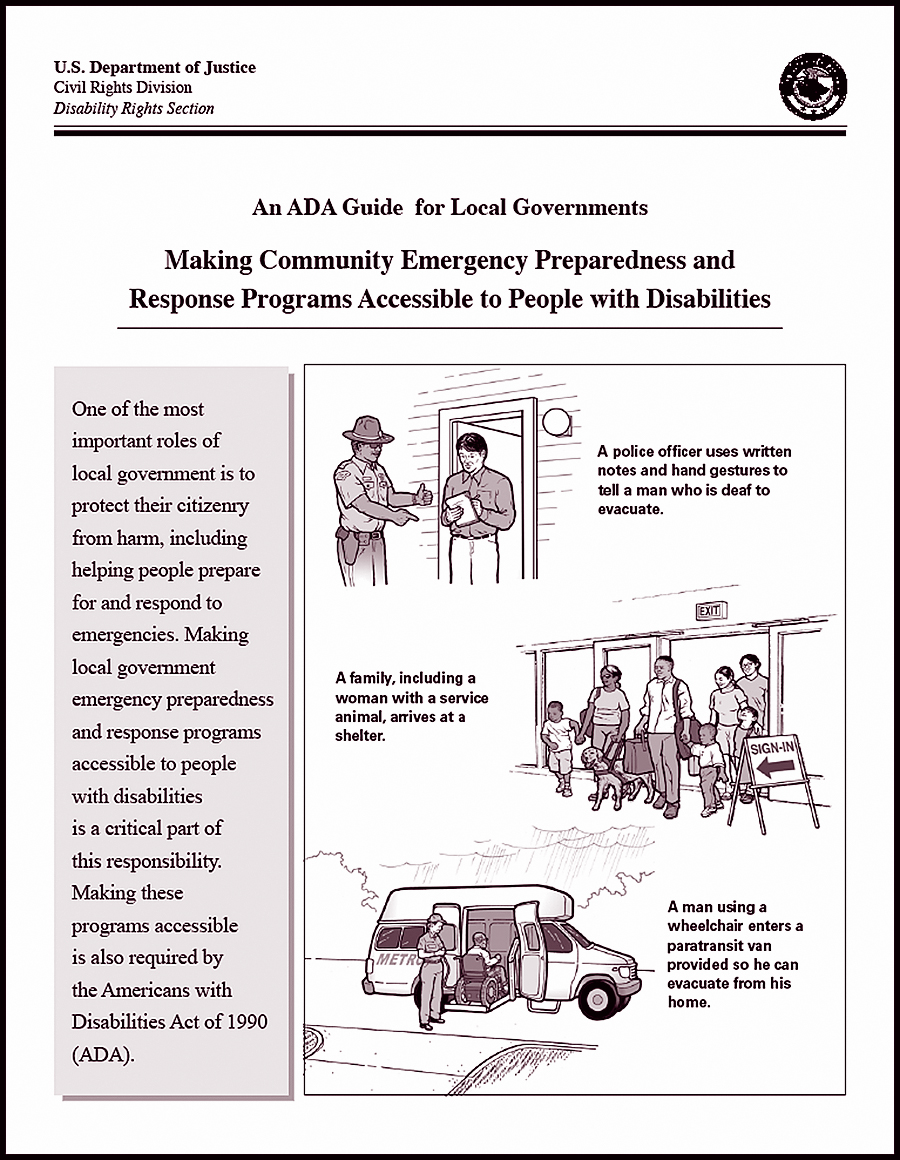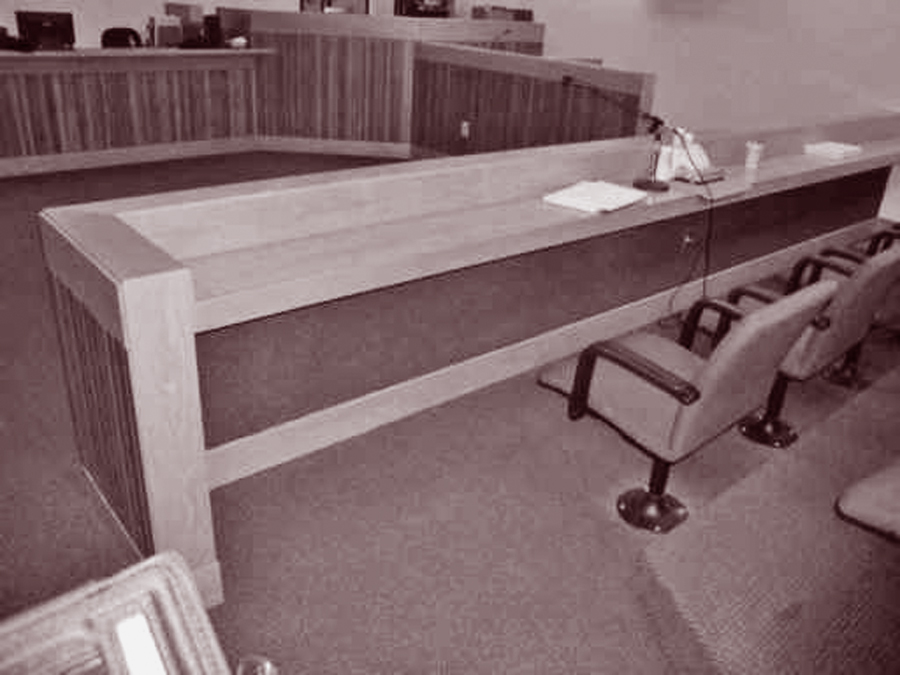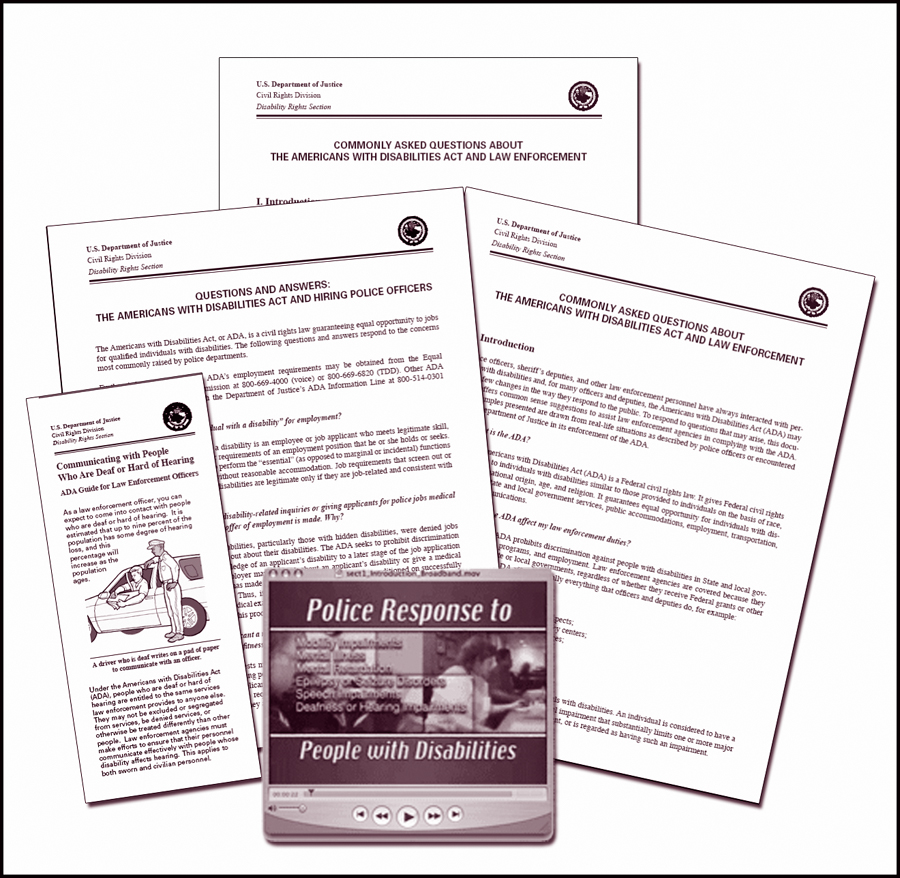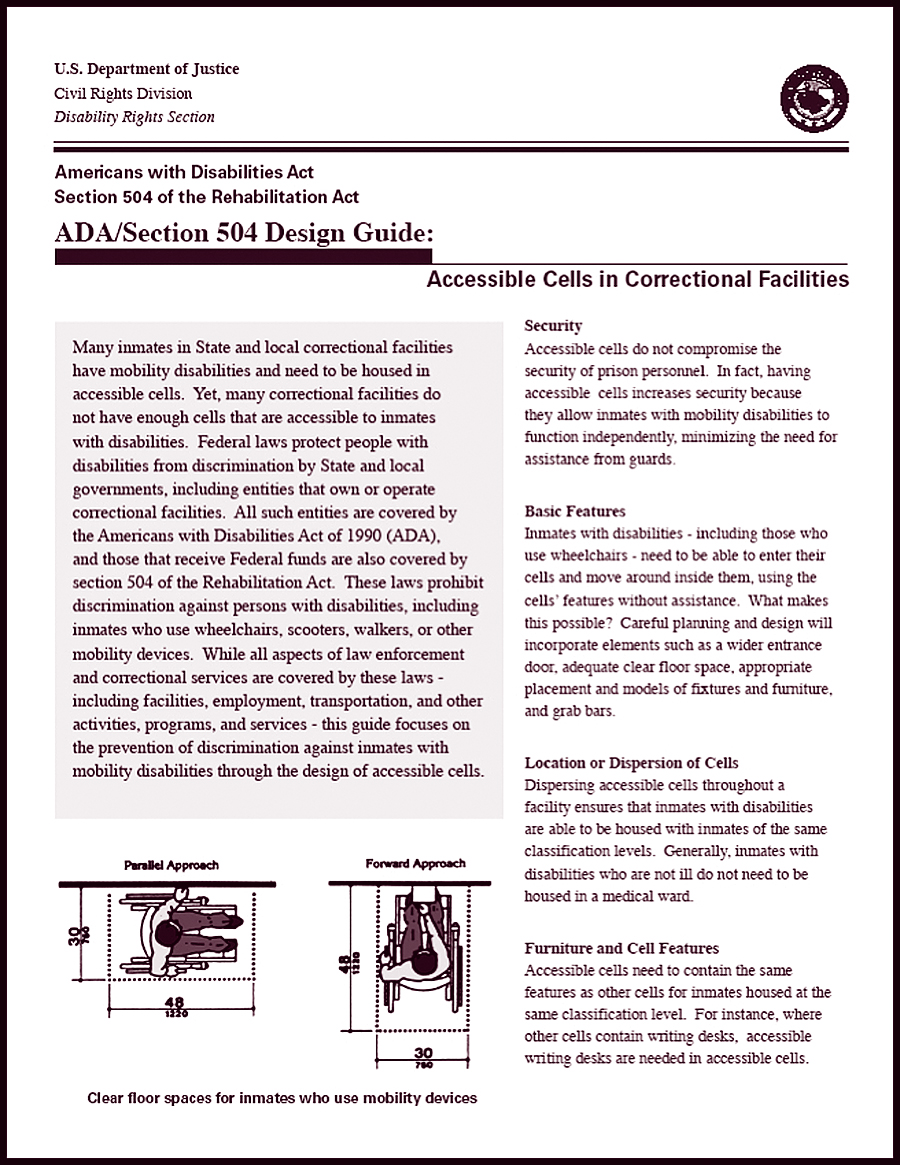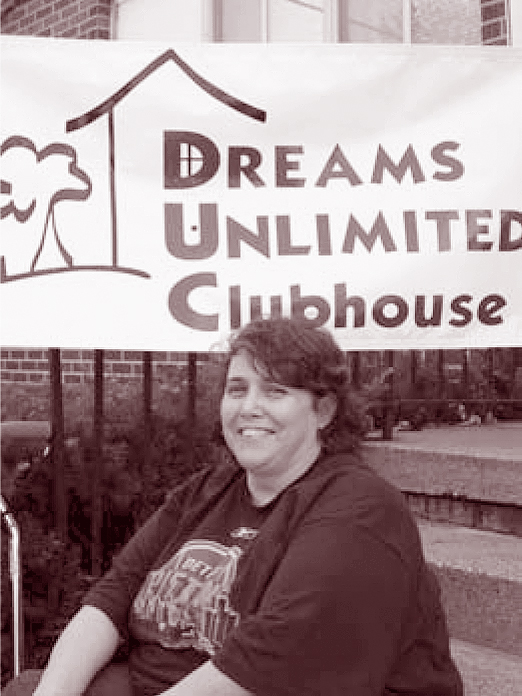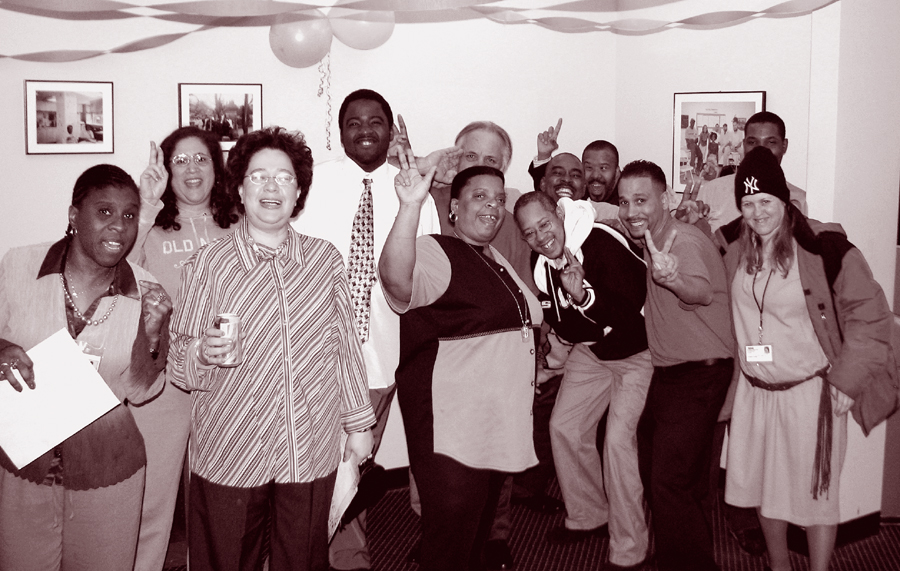| II. ENFORCING THE ADA PART 1 A. Enhancing Civic Participation 1. Project Civic Access "I want to say that the Americans with Disabilities Act allowed me to get places, gave me more to do. I will be able to go places and get around the neighborhood a lot easier and safer. Thanks." - Ross Soliel Palmer, nine-year-old resident of Santa Fe, New Mexico, at August 5, 2004, Department of Justice roundtable, Washington, D.C. Most Americans take for granted their ability to attend a civic meeting, use public sidewalks, call 9-1-1 in an emergency, or show up at the polls to vote for candidates of their choice. For too many people with disabilities, however, these seemingly routine aspects of American life have poseddaunting challenges and, in some cases, been altogether unavailable. When a municipal courthouse is not accessible, people who use wheelchairs cannot serve on juries, attend hearings, or appear in court as witnesses.When a town hall is not accessible, persons with disabilities cannot participate in town meetings or other civic programs. When sidewalks do not have curb ramps, people with mobility disabilities are unable to move around freely to get to city hall, the department of motor vehicles, or the local public elementary school. When a city does not provide sign language interpreters at a zoning hearing or other program, persons with hearingimpairments may not be able to participate. And if government websites are not designed to work with assistive technologies – like screen readersand voice recognition software – blind individuals and persons who cannot use a mouse may not be able to renew their drivers' licenses, file their tax returns, or apply for government jobs and programs online. Access to civic life is a fundamental goal of the ADA. To ensure that this goal is met, Title II of the ADA requires state and local governments to make their programs and services accessible to persons with disabilities. Federal regulations require state and local governments to make reasonable modifications to policies, practices, and procedures whenever necessary to avoid discrimination, unless such modifications would fundamentally alter the government program or service. Under federal regulations, state and local governments also must take appropriate steps to ensure that they can communicate effectively with people with disabilities, using auxiliary aids and services where necessary. Initially, the Department of Justice focused its enforcement efforts for cities, counties, and other forms of local government on resolving discrete problems brought to its attention through citizen complaints. The Department created Project Civic Access in order to marshal its investigative and technical assistance capabilities in a more comprehensive approach to solving accessibility issues on a community-wide basis. A key step in Project Civic Access is the Department's bottom-up review of a city's or county's public spaces and services. Some Project Civic Access reviews follow complaints received by the Department, but many are initiated by the Department. The Department endeavors to conduct reviews in every state, across locations with a range of population sizes, and in communities that are demographically diverse. When President Bush took office in 2001, he made Project Civic Access one of his top ADA priorities through the New Freedom Initiative. In August 2004, the Department commemorated the 100th Agreement signed under Project Civic Access. As of the printing of this Report, the Department has reached 150 agreements with 141 state and local governments to bring them into compliance with the ADA. Several of these agree-ments are available at www.ada.gov/civicac.htm. On a Project Civic Access review, Department attorneys, investigators, and architects survey a range of programs and activities, including those conducted in the city and town halls; courthouses; police, fire, and sheriff's departments; centers for health care, childcare, teen, and senior activities; libraries; convention centers; stadiums; emergency shelters; polling places; and parks and recreational facilities. Typical issues ad-dressed during a Project Civic Access compliance review include:
The Department has published two guides specifically designed to assist local officials, which are available on its www.ada.gov website. These booklets, entitled "The ADA Guide for Small Towns"2 and "The ADA and City Governments: Common Problems,"3 review the ADA's requirements and offer practical ways of meeting those requirements in cities and small towns. Project Civic Access is much more than an inspection program. In fact, the inspection is just the beginning of a truly cooperative venture among the Department, the local jurisdiction, and its citizens. Local government officials have responded favorably and cooperated fully in the Department's reviews. They have provided requested records and documents in a timely fashion, have made themselves available to answer questions during on-site visits, and have escorted investigators throughout their communities in order to assist in the quick and efficient completion of facilities surveys. Sometimes these site reviews result in on-the-spot changes to improve access. Most important, these officials have indicated a willingness to undertake changes in order to make their programs and services accessible to persons with disabilities. Local officials like Sara Boesser, a building inspector in Juneau, Alaska, usually accompany the Department's staff on their reviews. "It was a wonderful experience to go around watching someone else do all those measurements, but also just to be able to learn from the experts from the Department of Justice and learn some of the things we didn't know," said Ms. Boesser. "The most unexpected pleasure from all of it is the help that DOJ has given us with plan review questions ever since. The more of that service you can offer building departments around the world, the more they're going to give you good service from their end."4 After conducting a location review, investigators discuss their findings with local officials and draft settlement agreements to resolve any outstanding issues. Through Project Civic Access, the Department has learned that the vast majority of communities are aware of their ADA obligations and are making progress toward meeting those obligations. Local officials in Allen County, Indiana,were pleasantly surprised by their experience with Project Civic Access. When the county commissionlearned that the Department intended to review the local government's ADA compliance, "I think we were very apprehensive," said Marla Irving, a county commissioner who worked with Department officials on their inspection. "We knew that we had some issues . . . . [B]eing ADA compliant isnot always the easiest endeavor to do." But DOJ officials worked closely with local officials toreach an agreement. "It was just a great learning experience foreveryone involved. It was not adversarial," said Brian Dumford, the county's human resources director and ADA coordinator.In fact, county maintenance crews began making changes before the Department finishedits investigation.5 The results of Project Civic Access are encouraging. In Davenport, Iowa, for example, Project Civic Access will make a real difference for people like John Sparks, who became disabled in a motorcycle accident. Mr. Sparks has a daughter who loves to dance and sing. Her mother took her to classes at Davenport's Junior Theater because Mr. Sparks could not access the theater in his wheelchair. In a 2004 Project Civic Access settlement agreement,6 the city agreed to remedy several elements at the Junior Theater, including widening the main entrance to make it accessible, fixing the exterior ramp, and adding wheelchair seating in the auditorium. After the agreement is fully implemented, Mr. Sparks will be able to take his daughter to classes and enjoy her performances as well. "I just want to take this time to thank the city of Davenport, the ADA, Project Civic Access, and the Department of Justice as a whole... With all the On August 5, 2004, citizens from across the nation came to the Justice Department to celebrate the signing of the 100th Project Civic Access settlement agreement. Events included a roundtable discussion where local government officials, community advocates, and individuals with disabilities from seven communities shared their experiences with Project Civic Access and the positive impact it has had.7
The Department has recently launched the second phase of Project Civic Access, which involves reviewing additional communities in all 50 states and focuses on an expanded range of issues, including accessible curb cuts, voting technology, disaster response planning, domestic violence shelters, and government websites.By increasing the scope of our reviews, the Department will improve access in new communities and ensurethat people with disabilities can fully participate in the fundamental aspects of contemporary American life.Their increased participation benefits their entire community and all Americans.
In addition to addressing disaster preparedness for people with disabilities through Project Civic Access, the Department of Justice has worked jointly with the Department of Housing and Urban Development (HUD) to provide technical assistance to the Federal Emergency Management Agency (FEMA) on its transitional housing program. FEMA uses three types of emergency transportable housing to provide transitional homes to people displaced by disasters: travel trailers,one- and two-bedroom recreational vehicles, and three-bedroom manufactured homes. After Hurricanes Katrina, Rita, and Wilma in 2005, the Department dispatched an architect with expertise in disability and accessibility issues to review FEMA's group trailer sites situated near Baton Rouge, to meet with FEMA staff responsible for providing transitional housing to disaster victims in that region, and to inspect the emergency transportable housing being used to house people with mobility disabilities. The Department's architect met with FEMA officials and contractors to discuss strategies for improving accessible housing options for people with mobility disabilities. Department employees advised the FEMA contractor responsible for constructing group trailer sites about how to build ramps for the units that would house individuals with mobility disabilities. Working jointly with HUD, the Department then prepared guidelines and a model floor plan for an accessiblethree-bedroom manufactured home, which enabled FEMA to quickly procure accessible units for the disaster area. To ensure that people with mobility disabilitieshoused at FEMA's group trailer sites would have access to common areas, such as food distribution areas, mail facilities, recreation areas, and laundry facilities, theDepartment also prepared guidelines FEMA could use to ensure that its group trailer and mobile home sites were designed to be fully accessible. After this initial workwas completed, the Department continued to provide technical assistance to officials in Louisiana and Mississippi.
In this publication, the Department recommends a series of proactive steps that local governments should take in order to meet the needs of people with disabilitiesin emergencies:
9-1-1 systems are regularly mandated as part of the Department's Project Civic Access agreements. 3. Access To And Fair Treatment In The Legal System Interacting with law enforcement officials, participating in court proceedings, and being incarcerated are some of the most stressful encounters that citizens can have with government. Imagine how much greater the stress is for people who, simply because of their disabilities, cannot hear what a police officer is saying to them, cannot climb the steps to the courthouse door, or cannot participate in the counseling and rehabilitative services available to other inmates. Judges, attorneys, court staff, and potential jurors with disabilities also face daunting challenges when attempting to fulfill their roles in the legal process. The Department is working with state and local governments around the country to eliminate these inequities. Through Project Civic Access, the Department has worked closely with numerous counties and towns to ensure that courthouses and courtrooms are accessible. Settlement agreements have required modifications to jury seating and deliberation areas, judges' benches, spectator seating, and routes of travel so that they are accessible to people with mobility disabilities.
The Department also uses litigation when necessary to ensure access by the disabled to the judicial system. For example, in 2004 the Department brought and settled a lawsuit against the Commonwealth of Massachusetts and Bristol County, Massachusetts, alleging that they failed to make the services, programs, and activities of the county's trial courts and registries of deeds accessible to people with mobility disabilities. The lack of physical accessibility - courtrooms and registry offices were located up flights of stairs in buildings without ramps or elevators - allegedly prevented two lawyers with disabilities who were named as plaintiffs in the lawsuit and other lawyers, parties, witnesses, jurors, spectators, and citizens with disabilities from gaining access to the services of five courthouses and three registries of deeds offices. Massachusetts agreed to make structural changes at each courthouse by constructing an elevator or ramp, along with accessible restrooms. The agreement also called for modifications of procedures to ensure that any services or programs located in inaccessible areas in a courthouse would be provided to lawyers, parties, witnesses, jurors, and spectators in an accessible area. In addition, Bristol County agreed to construct a ramp or elevator and accessible restrooms at its registries of deeds offices to ensure physical access to the registries and their services. Until these structural changes are completed, each registry will serve people with mobility disabilities via mail, internet, facsimile, and curbside service.14 In addition to physical accessibility issues, Project Civic Access agreements have required counties and towns to ensure that people who are deaf or hard of hearing receive appropriate auxiliary aids and services during court proceedings. For example, in November 2003, the State of Connecticut Judicial Branch, Superior Court Operations Division in Hartford, Connecticut, entered into an agreement with the Department resolving a complaint alleging that the state had failed to provide a sign language interpreter for a man who is deaf at three judicial proceedings. Under the agreement, the state will furnish appropriate auxiliary aids and services, including qualified sign language and oral interpreters, where necessary in the future to ensure effective communication with individuals with disabilities.15 The most frequent ADA complaint the Department receives against law enforcement agencies and officers is that they do not provide effective communication with people who are deaf or hard of hearing. For example, a complainant who is deaf alleged that the Phoenix Police Department discriminated against him on the basis of his hearing disability by failing to provide him with a qualified sign language interpreter at the time of his arrest. In an April 2003 agreement, Phoenix agreed to integrate a policy on effective communication into the police department's operations manual. Employees were trained in the requirements of the policy, a notice was published in the local newspaper regarding the new policy, and mandatory ADA training sessions were held for all sworn personnel in order to instruct them to comply with the provisions of the agreement.16 Similarly, the Michigan Department of Human Services entered into an April 2006 agreement resolving two complaints filed by deaf parents who alleged that the state had refused to provide them with interpreters when they were interviewed by case workers during child abuse and neglect investigations involving their children. Michigan agreed to (1) adopt a new effective communication policy; (2) require case workers to indicate on a revised intake form if a parent has a disability and requires an interpreter for effective communication; (3) issue a public notice regarding the ADA's applicability to the agency; (4) update its hotline numbers, its website, and other pertinent literature to include a TTY number and the Michigan relay number;17 and (5) train its 150 managers and 9000 employees annually on the ADA and its requirement to provide interpreters when necessary for effective communication.18 "This disability rights initiative demonstrates the Department's continuing commitment to help state and local governments – including law enforcement – understand and comply with the ADA," - Civil Rights Division Assistant Attorney General Wan J. Kim, announcing the Law Enforcement Outreach initiative on May 2, 2006. To help state and local law enforcement agencies understand their responsibilities under the ADA, on April 28, 2006, the Department finished sending a mailing to 25,000 police departments, sheriff's offices, highway patrols, and other state and local law enforcement agencies throughout the country, offering a variety of free ADA publications and videotapes developed specifically for law enforcement audiences. The mailing included two new compliance assistance publications – a brochure for officers19 and a model policy20 – on how to communicate effectively with people who are deaf or hard of hearing. The agencies also received information on how to order the videotape "Police Response to People with Disabilities." Intended for roll-call training, the video is divided into eight different five- to ten-minute segments that address law enforcement situations involving people who have mobility, speech, hearing, or vision disabilities, mental illness, mental retardation, or epilepsy or other seizure disorders. A fully accessible streaming version of the video is also available for viewing on the ADA website (www.ada.gov),21 enabling officers whose vehicles are equipped with internet access to quickly review the relevant segment for guidance when interacting with a person with a disability as a witness, suspect, victim, or person in need of assistance.22
The Department has also investigated and resolved complaints from individual prisoners, obtaining relief that significantly affects the quality of an inmate's life while incarcerated. One of the most widespread complaints is the failure to provide effective communication to inmates with disabilities. This failure often prevents inmates who are deaf or hard of hearing from participating in an array of medical, social, and educational programs offered at a facility. They miss medical appointments, pill calls, and meals because they cannot hear announcements. Blind prisoners and prisoners with low vision complain that they cannot get books on tape or in large print. In 2004, the Department entered into a settlement agreement resolving a complaint by a Maryland juvenile who was deaf and used American Sign Language. The young man served 18 months in two juvenile detention facilities, where he was required to participate in rehabilitative, educational, and recreational programs. However, because the facilities allegedly failed to provide him with adequate sign language interpreter services, he was usually unable to participate in or benefit from these programs. As a result of the Department's investigation, Youth Services International, a private corporation that operates juvenile justice facilities in eight states, and the State of Maryland Department of Juvenile Services entered into a settlement agreement with the Department.They agreed to provide qualified sign language interpreters or other appropriate auxiliary aids for youths who are deaf or hard of hearing in all of their juvenile facilities and programs, including intake and orientation, medical and psychological evaluations, treatment meetings, educational classes, therapy or group sessions, one-on-one meetings, school or assemblies, group living time, and exit interviews. Maryland will also provide these services for probation meetings and aftercare programs. In addition, each facility will provide visual alarms, hearing aid-compatible and volume-controlled telephones, TTYs, and closed captioning equipment for youth who are deaf or hard of hearing, and will train staff on the requirements of the ADA.26 Inmates in Anne Arundel County, Maryland and Hennepin County, Minnesota will benefit from similar relief as a result of Department investigations. In 2005, Anne Arundel's Department of Detention Facilities entered into a settlement agreement to improve services provided to people who are deaf or hard of hearing at its two detention centers.27 The County agreed to appoint an ADA coordinator at each facility; develop and implement a training program for staff; conduct a hearing assessment of all persons within 24 hours of their admittance; provide qualified sign language interpreters or other auxiliary aids during orientation, disciplinary hearings, reclassification hearings, classification appeals, status reviews, program meetings, meetings with program specialists, and rehabilitative or educational programs; and provide TTYs, closed captioning equipment, and visual alarms at each facility. Hennepin County entered into a similar agreement to resolve a complaint from an adult inmate who is deaf alleging that the county failed to provide an interpreter for chemical dependency treatment and other programs.28 In another case, two inmates who are deaf in the District of Columbia challenged the denial of their request for auxiliary aids necessary for effective communication during their stay in a halfway house. In 2003, the D.C. Department of Corrections agreed to establish policies for providing appropriate auxiliary aids and services, including qualified interpreters, hearing aid batteries, telephones with amplified handsets, closed captioning for televisions, and visual and tactile alarms. The D.C. Department of Corrections also agreed to provide notice to inmates of the availability of these services, to train staff in carrying out the auxiliary aids policy, and to terminate contracts with entities that violate the policy in providing services to inmates.29 Another common complaint is that correctional facilities are not accessible to inmates and visitors with mobility impairments. In 2004, the City of New Hope, Alabama signed an agreement resolving a complaint that neither its jail nor its city hall were accessible.30 The city agreed to book and house prisoners with mobility impairments in accessible facilities in a neighboring county jail. The city also agreed to provide accessible door hardware throughout its facility, a TTY, van-accessible parking, and an accessible drinking fountain. Similar obstacles to persons with disabilities were alleged to have occurred at the Cheatham County Jail in Tennessee. In 2003, the County Jail signed an agreement requiring it to provide accessible parking, handrails for the entrance ramp, accessible public toilet rooms, an accessible drinking fountain, a designated accessible inmate cell and shower, inmate telephones mounted at an accessible height, and audible emergency warning systems in holding cells or areas. The settlement also requires Cheatham County to provide a text telephone for inmates who are deaf or hard of hearing or who have a speech impairment.31 As the inmate population continues to age, it will be increasingly important that correctional facilities understand and comply with the accessibility requirements of the ADA. Inmates with disabilities will not be able to fully participate in and benefit from the variety of educational, rehabilitational, and substance abuse treatments at the heart of corrections programs unless these institutions and thoseprograms are accessible. Ensuring this access and the potential rehabilitation of inmates with disabilities is vital both for those inmates and for the communities to which they will return when they complete their sentences. 4. Ensuring Nondiscriminatory Zoning and Commercial Leasing Policies Some of the damaging consequences of disability discrimination are the isolation and segregation of persons with disabilities. In passing the ADA, Congress recognized that such forms of discrimination result in social, vocational, economic, and educational disadvantages to individuals with disabilities, and that such practices run counter to the Nation's goals of assuring equality of opportunity and full participation in society.32 Especially where a disability is based on a mental disorder or mental illness, negative stereotypes and unfounded fears can be formidable obstacles to achieving the type of integration and participation envisioned by the ADA. One of the ways in which the Department furthers the goal of full participation is through enforcement of the Act's prohibitions against discriminatory zoning and commercial leasing practices. "I was very happy when I heard that Easter Seals-Michigan and the Department of Justice were willing to stand up for people with psychiatric disabilities... It proved that we matter just like every other citizen The Department has resolved several Title II and Title III complaints alleging discriminatory zoning and commercial leasing practices. For example, in 2005 the Department intervened in a lawsuit brought by Easter Seals of Michigan against the City of Royal Oak, Michigan, to challenge the city's denial of a land-use permit for a day program for adults with mental illness. For over fifteen years Easter Seals had operated the Dreams Unlimited Clubhouse in a neighboring town, providing vocational training, skill building, volunteer service programs, and a social network for participants. When Easter Seals sought to relocate to a larger facility inRoyal Oak, the organization took what it anticipated would be routine steps to obtain the necessary permits to operate the Clubhouse.However, in a series of public hearings before the city's zoning boards, community members protested against the Clubhouse location. Commenters expressed their belief that the presence of the Clubhouse would lower property values and fear that the neighborhood wouldno longer be safe for children. And an official on the city's planning commission signed petitions opposing the Clubhouse before chairinga hearing on the permit issue. The land-use permit was denied, and Easter Seals filed suit, seeking the right to operate the Clubhouse in Royal Oak. After investigation, the Department concluded that the city had discriminated against Easter Seals and its members by impermissibly basing its decision to deny the land-use permit on the fact that the users of the facility would be persons with mental illness. The Department intervened in the lawsuit and worked with the parties to resolve the matter. Under the November 2005 consent decree, Easter Seals was granted the land-use permit to operate the Clubhouse at the desired location and the city paid money damages to the private plaintiffs.33 In addition, city officials participated in mandatory training on the ADA, which was conducted by Civil Rights Division staff. In another zoning matter, in July 2003 the Department resolved a complaint that the City of Jackson, Mississippi, allegedly refused a zoning change that would have allowed the construction of a mental health crisis intervention center. In public hearings related to the zoning request, members of the public as well as council members allegedly made comments reflecting negative stereotypes about people with mental illness and voiced opposition to the center. Following these meetings, the city council, acting in its capacity as the zoning board, voted to deny the developers' petition. Pursuant to the settlement agreement with the United States, the city held a new vote based on appropriate and lawful criteria, and granted the petition.34 The city paid the developers $40,000 in compensatory damages and provided ADA training to all city council and planning board members on the requirements of the ADA. The city also agreed that in the future it would use appropriate, nondiscriminatory criteria when evaluating zoning petitions involving people with disabilities. "This was a particularly difficult time for Sinergia...After searching over 50 sites in Manhattan we finally decided on a site only to be leveled with discrimination against our consumers with developmental disabilities. It was a bleak time as winter approached and we struggled to find an affordable alternative...Please accept our profoundest gratitude on behalf of individuals with disabilities and our entire organization. Be assured that this was a unique and wonderful opportunity for our consumers to practice self-empowerment and to witness firsthand justice at work." - Letter from Myrta Cuadra-Lash, Executive Director, Sinergia, (March 30, 2006) Discrimination against people with disabilities also occurs in commercial leasing. Under Title III, the Department resolved a complaint filed by Sinergia, a small, nonprofit social service organization that operates a day habilitation program for adults with mental retardation and developmental disabilities. For over twenty years, Sinergia has offered educational, vocational, and social services primarily to low-income, minority communities traditionally underserved by other service providers. When Sinergia sought a new location for its day program in Manhattan, Kaufman Realty Corporation refused to lease to Sinergia because other tenants in the commercial building objected to the fact that Sinergia's clientele would be adults with mental retardation. After investigation of the complaint, the Depart-ment notified Kaufman Realty that it was in violation of Title III and the parties agreed to resolve the matter with a consent decree. Under the consent decree, Kaufman Realty agreed to conduct all commercial leasing practices in a nondiscriminatory manner and to pay $175,000 to Sinergia as compensation for monetary damages.35
"Prejudice, once let loose, is not easily cabined." - Justice Thurgood Marshall 36 Prohibiting discrimination in zoning and commercial leasing is at the heart of the ADA. The Department will continue to enforce the ADA vigorously with respect to zoning and commercial leasing practices to ensure that persons with disabilities and organizations providing services to such individuals enjoy the full and equal opportunities protected by the Act. Footnotes 2 U.S. Dep't of Justice, The ADA Guide for Small Towns, available at http://www.ada.gov/smtown.htm. 3 U.S. Dep't of Justice, The ADA and City Governments: Common Problems, available at http://www.ada.gov/comprob.htm. 4 Disability Rights Online News, August/September 2004, available at http://www.ada.gov/newsltr0804.htm. 5 County to Boost Disabled Access, Ft. Wayne News Sentinel, June 29, 2005, Page A1. 6 Settlement Agreement between the United States and the City of Davenport, Iowa (Aug. 5, 2004), available at http://www.ada. gov/DavenportSA.htm. 7 More highlights from the roundtable discussion are available on the Department's website at http://www.usdoj.gov/ 8 Settlement Agreement between the United States and the City of Newark, N.J. (May 31, 2006). 9 Settlement Agreement between the United States and the City of Memphis, Tenn. (July 25, 2005), available at http://www.ada. gov/memphistnsa.htm. 10 Settlement Agreement between the United States and Arlington County, Va. (Mar. 30, 2006), available at http://www.ada. gov/arlingsa.htm. 11 Settlement Agreement between the United States and Loudon County, Va. (July 25, 2003), available at http://www.ada. gov/loudon.htm. 12 Settlement Agreement between the United States and the County of Maui, Haw. (Sept. 26, 2005), available at http://www.ada. gov/mauisa.htm.crt/ada/newsltr0804.htm. 13 U.S. Dep't of Justice, An ADA Guide for Local Governments: Making Community Emergency Preparedness and Response Programs Accessible to People with Disabilities, available at http://www.ada.gov/emergencyprepguide.htm. 14 Settlement Agreement between the United States and the Commonwealth of Massachusetts and Bristol County, Massachusetts (Jan. 9, 2004), available at http://www.ada.gov/bristolco.htm. 15 Settlement Agreement between the United States and Connecticut Judicial Branch of Hartford, Conn. (Nov. 3, 2003). 16 Settlement Agreement between the United States and the City of Phoenix Police Dep't, Ariz. (Apr. 7, 2003). 17 The Michigan relay number is part of the telecommunications relay service, a free nationwide service that allows people who use text telephones to communicate with those using telephones. An operator with a TTY terminal receives text from the TTY user and relays that message to the other party, and vice versa. 18 Settlement Agreement between the United States and the Dept. of Human Services, Mich. (Apr. 12, 2006). 19 U.S. Dep't of Justice, Communicating with People who are Deaf or Hard of Hearing, available at http://www.ada.gov/lawenfcomm.htm. 20 U.S. Dep't of Justice, Model Policy for Law Enforcement on Communicating with People Who are Deaf or Hard of Hearing, available at http://www.ada.gov/lawenfmodpolicy.htm. 21 Videotape: Police Response to People with Disabilities (U.S. Dep't of Justice), available at http://www.ada.gov/videogallery.htm. 22 The brochure, model policy, and additional copies of the video can be ordered through the ADA website (www.ada.gov) or the ADA Information Line (800-514-0301 (voice), 833-610-1264 (TTY)), both of which are operated by the Department's Disability Rights Section. 23 U.S. Dep't of Justice, Corrections Statistics: Prisoners in 2004 and Probation and Parole in the United States, 2004, available at http://www.ojp.usdoj.gov/bjs/glance/corr2.htm. 24 U.S. Dep't of Justice, Mental Health Treatment in Prisons, 2000, NCJ 188215 (July 2001), available at http://www.ojp. usdoj.gov/bjs/pub/pdf/mhtsp00.pdf. 25 U.S. Dep't of Justice, ADA/Section 504 Design Guide: Accessible Cells in Correctional Facilities, available at http://www.ada.gov/accessiblecells.htm. 26 Settlement Agreement between the United States and the Md. Dep't of Juvenile Services and Youth Services Intl., Inc. (Mar. 29, 2004), available at http://www.ada.gov/mdjs.htm. In 2006, Youth Services International entered into a second settlement agreement to resolve a suit filed by the Department under Title III of the ADA alleging failure to provide a sign language interpreter to a Maryland juvenile as well as failure to comply with the 2004 agreement. Settlement agreement between the United States and Youth Services Intl., Inc. (D. Md. July 11, 2006), available at http://www.ada.gov/ysi.html. 27 Settlement Agreement between the United States and Anne Arundel County, Md. (Nov. 28, 2005), available at www.ada.gov/ annearundel.html. 28 Settlement Agreement between the United States and Hennepin County, Minn. (Dec. 6, 2005). 29 Settlement Agreement between the United States and the Department of Corrections, D.C. (Mar. 20, 2003). 30 Settlement Agreement between the United States and the City of New Hope, Ala. (Apr. 7, 2004). 31 Settlement Agreement between the United States and Cheatham County Jail, Tenn. (Jan. 22, 2003), available at http://www. ada.gov/cheatham.html. 32 See 42 U.S.C. § 12101. 33 Easter Seals-Michigan and United States v. City of Royal Oak, Michigan, No. 05-60010 (E.D. Mich. Nov. 29, 2005), available at http://www.ada.gov/michigan.htm. 34 Settlement Agreement between the United States and the City of Jackson, Mississippi (July 17, 2003), available at http://www.ada.gov/jackson.htm. 35 United States v. Kaufman Realty Corp., No. 06-2021 (S.D.N.Y. March 15, 2006). 36 City of Cleburne v. Cleburne Living Center, 473 U.S. 432, 464 (1985) (Marshall, J., concurring). |
||||||||||||||
Back to Table of Contents
